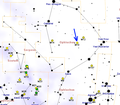Messier 10
| Messier 10 | |
|---|---|
 Globular cluster Messier 10 in Ophiuchus | |
| Observation data (J2000 epoch) | |
| Class | VII[1] |
| Constellation | Ophiuchus |
| Right ascension | 16h 57m 8.92s[2] |
| Declination | −04° 05′ 58.07″[2] |
| Distance | 14.3 kly (4.4 kpc)[3] |
| Apparent magnitude (V) | 6.6[4] |
| Apparent dimensions (V) | 20.0′ |
| Physical characteristics | |
| Mass | 2.25 × 105[5] M☉ |
| Radius | 41.6 ly[6] |
| Metallicity | = –1.25[7] dex |
| Estimated age | 11.39 Gyr[7] |
| Other designations | GCl-49, NGC 6254[8] |
Messier 10 or M10 (also designated NGC 6254) is a globular cluster of stars in the equatorial constellation of Ophiuchus. The object was discovered by the French astronomer Charles Messier on May 29, 1764, who cataloged it as number 10 in his catalogue and described it as a "nebula without stars". In 1774, German astronomer Johann Elert Bode likewise called it a "nebulous patch without stars; very pale". Using larger instrumentation, German-born astronomer William Herschel was able to resolve the cluster into its individual members. He described it as a "beautiful cluster of extremely compressed stars". William Parsons, 3rd Earl of Rosse thought he could distinguish a dark lane through part of the cluster. The first to estimate the distance to the cluster was Harlow Shapley, although his derivation of 33,000 light years was much further than the modern value.[9]
The tidal radius of M10 is 19.3 arcminutes, which is about two-thirds of the apparent diameter of the Moon. Viewed through medium-sized telescopes it appears about half that size (8–9 arcminutes), as its bright core is only 35 light-years across. It has a core radius of 48 arcseconds and a half-mass radius of 147 arcseconds (2.5 arcminutes).[2] M10 has a spatial diameter of 83 light-years and is estimated to be 14,300 light-years away from Earth.[3] It figures a degree west of 30 Ophiuchi, a center-of-constellation orange star.[10]
In terms of the abundance of elements other than hydrogen and helium, what astronomers term the metallicity, Messier 10 is "moderately metal–poor". The abundance of iron, measured as [Fe/H] equals –1.45 ± 0.04 dex, is only 3.5% of the abundance found at the surface of the Sun.[11] The cluster shows evidence of being enriched by the elements generated through the s-process in massive stars and Type II supernovae. It shows little evidence of enrichment by Type Ia supernovae.[12]
Because binary stars are, on average, more massive than normal stars, the binaries tend to migrate toward the center of the cluster. The fraction of binary stars in the core region is about 14%. This proportion decreases with increasing radius to about 1.5% in the outlying regions of the cluster.[2] Correspondingly, the core region contains a concentration of interaction-formed blue straggler stars, most of which formed 2–5 billion years ago.[13] The density of stars in the core region is about 3.8 solar masses per cubic parsec.[2] Four variable stars have been discovered in this cluster.
The cluster is currently located about 5 kiloparsecs (16 kly) from the Galactic Center.[12] It completes an orbit around the Milky Way galaxy about every 140 million years, during which it crosses the plane of the galactic disk every 53 million years. Its rosette orbit has an eccentricity of 0.21.[5]
Gallery[edit]
-
Core region of Messier 10 by Hubble Space Telescope
-
Map showing location of Messier 10
See also[edit]
References[edit]
- ^ Shapley, Harlow; Sawyer, Helen B. (August 1927), "A Classification of Globular Clusters", Harvard College Observatory Bulletin, 849 (849): 11–14, Bibcode:1927BHarO.849...11S.
- ^ a b c d e Dalessandro, E.; et al. (December 2011), "The Binary Fraction in the Globular Cluster M10 (NGC 6254): Comparing Core and Outer Regions", The Astrophysical Journal, 743 (1): 11, arXiv:1108.5675, Bibcode:2011ApJ...743...11D, doi:10.1088/0004-637X/743/1/11, S2CID 119193839.
- ^ a b Bica, E.; et al. (April 2006), "Globular cluster system and Milky Way properties revisited", Astronomy and Astrophysics, 450 (1): 105–115, arXiv:astro-ph/0511788, Bibcode:2006A&A...450..105B, doi:10.1051/0004-6361:20054351, S2CID 1559058.
- ^ "Messier 10". SEDS Messier Catalog. Retrieved 27 April 2022.
- ^ a b Gnedin, Oleg Y.; Lee, Hyung Mok; Ostriker, Jeremiah P. (1999), "Effects of Tidal Shocks on the Evolution of Globular Clusters", Astrophysical Journal, 522 (2): 935–949, arXiv:astro-ph/9806245, Bibcode:1999ApJ...522..935G, doi:10.1086/307659, S2CID 11143134.
- ^ distance × sin( diameter_angle / 2 ) = 41.6 ly. radius
- ^ a b Forbes, Duncan A.; Bridges, Terry (May 2010), "Accreted versus in situ Milky Way globular clusters", Monthly Notices of the Royal Astronomical Society, 404 (3): 1203–1214, arXiv:1001.4289, Bibcode:2010MNRAS.404.1203F, doi:10.1111/j.1365-2966.2010.16373.x, S2CID 51825384.
- ^ "M 10". SIMBAD. Centre de données astronomiques de Strasbourg. Retrieved 2010-03-19.
- ^ Burnham, Robert (1978), Burnham's celestial handbook: an observer's guide to the universe beyond the Solar System, Dover Books on Astronomy, vol. 2 (2nd ed.), Courier Dover Publications, p. 1261, ISBN 978-0486235684.
- ^ O'Meara, Stephen James (1998). Deep-Sky Companions: The Messier Objects. Cambridge University Press. p. 63. ISBN 9780521553322.
- ^ Since 10−1.45 = 0.035.
- ^ a b Haynes, Sharina; Burks, Geoffrey; Johnson, Christian I.; Pilachowski, Catherine A. (October 2008), "Chemical Analysis of Five Red Giants in the Globular Cluster M10 (NGC 6254)", The Publications of the Astronomical Society of the Pacific, 120 (872): 1097–1102, arXiv:0808.2480, Bibcode:2008PASP..120.1097H, doi:10.1086/592717, S2CID 119203399.
- ^ Ferraro, Francesco R.; et al. (May 2003), "Blue Straggler Stars: A Direct Comparison of Star Counts and Population Ratios in Six Galactic Globular Clusters", The Astrophysical Journal, 588 (1): 464–477, arXiv:astro-ph/0301261, Bibcode:2003ApJ...588..464F, doi:10.1086/374042, S2CID 16109989.
External links[edit]
- Messier 10, SEDS Messier pages
- Messier 10, Galactic Globular Clusters Database page
- Messier 10 on WikiSky: DSS2, SDSS, GALEX, IRAS, Hydrogen α, X-Ray, Astrophoto, Sky Map, Articles and images

![{\displaystyle {\begin{smallmatrix}\left[{\ce {Fe}}/{\ce {H}}\right]\end{smallmatrix}}}](https://wikimedia.org/api/rest_v1/media/math/render/svg/4c0821bd80891e071c08e7c7ee8e022baedf522c)


